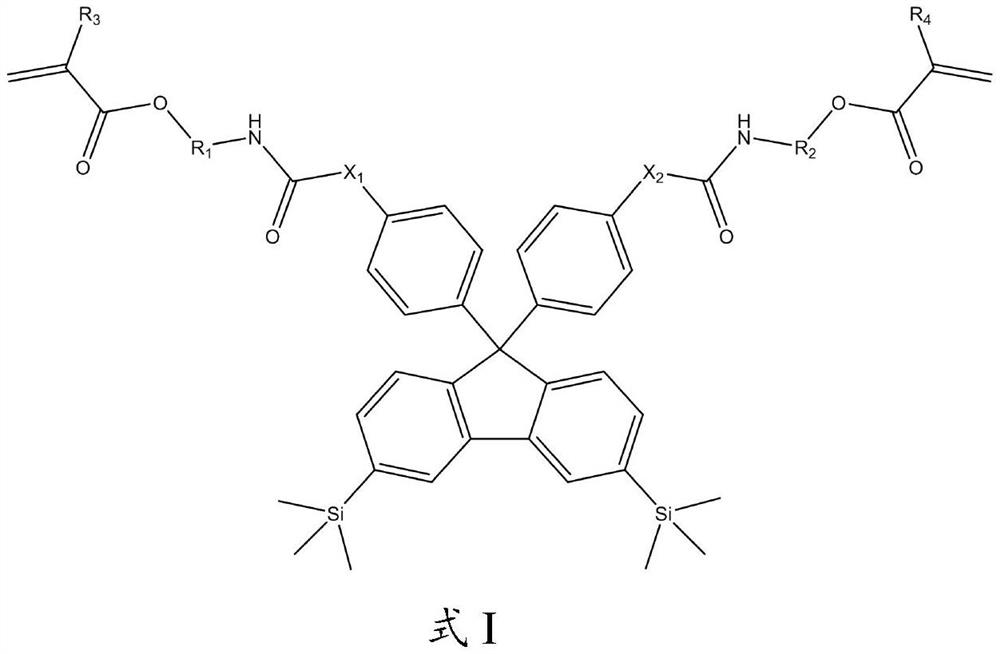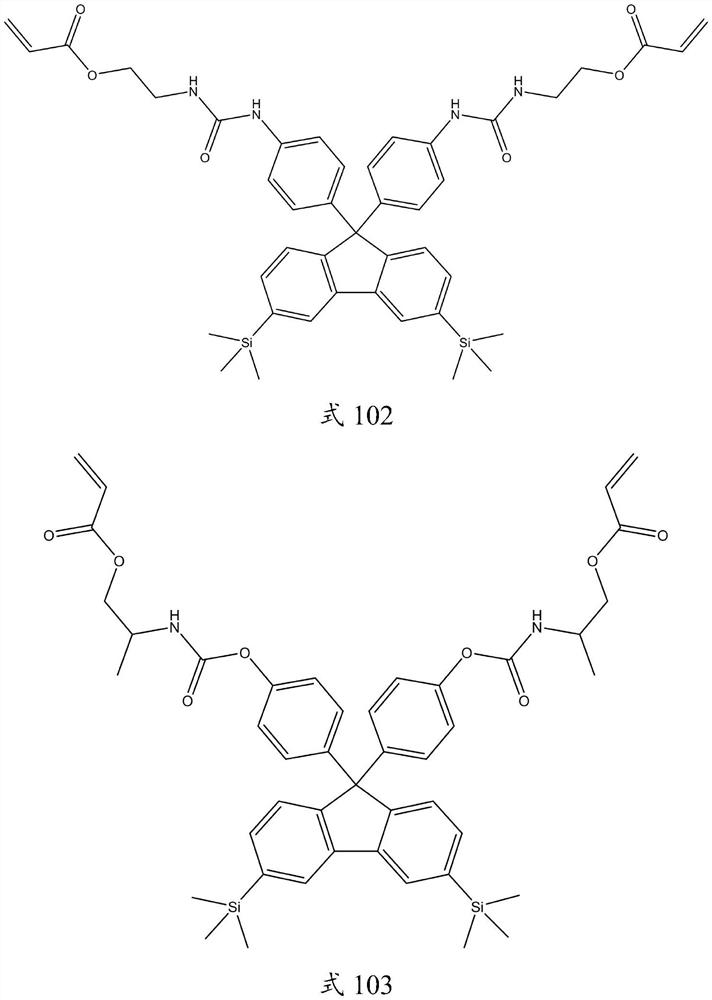Compound for thin film packaging, composition and packaging thin film
A technology of thin film encapsulation and composition, which is applied in the fields of compounds, organic chemistry, chemical instruments and methods of group 4/14 elements of the periodic table, can solve the problems of reducing water and oxygen transmission rate, and achieve good heat resistance, Improvement of reliability and effect of low water vapor transmission rate
- Summary
- Abstract
- Description
- Claims
- Application Information
AI Technical Summary
Problems solved by technology
Method used
Image
Examples
manufacture example 1
[0037] Production Example 1 Production of Compound 1 of Formula 101
[0038] 4,4'-(3,6-bis(trimethylsilyl)-9H-fluorene-9,9-diacyl)bisphenol (chemical formula 1) 52.2 g and 2-isocyanate ethyl methacrylate (chemical formula 2) 35.7 g was added to 150 mL of toluene to dissolve, and 0.3 g of dibutyltin dilaurate was added, followed by stirring for 4 hours while heating at 60°C. The temperature was cooled to room temperature, and the solvent was removed using a reduced pressure distiller to obtain 49.1 g of Compound 1 of Formula 101.
[0039]
[0040] The compound 1 was detected and analyzed, and the specific results were as follows:
[0041] HPLC purity: greater than 90%.
[0042] Mass Spec: Calculated 805.09; Tested 804.32.
[0043] Elemental analysis:
[0044] Calculated values: C: 67.13%; H: 6.51%; N: 3.48%; O: 15.90%; Si: 6.98%.
[0045] Tested values: C: 68.33%; H: 6.81%; N: 3.11%; O: 15.26%; Si: 6.49%.
manufacture example 2
[0046] Production Example 2 Production of Compound 2 of Formula 102
[0047] 4,4'-(3,6-bis(trimethylsilyl)-9H-fluorene-9,9-diacyl)diphenylamine (chemical formula 3) 52g and 2-isocyanate ethyl acrylate (chemical formula 4) 32.5 g g was added to 150 mL of toluene to dissolve, and 0.3 g of dibutyltin dilaurate was added, followed by stirring for 4 hours while heating at 60°C. The temperature was cooled to room temperature, and the solvent was removed using a reduced pressure distiller to obtain 46.6 g of compound 2 of formula 102.
[0048]
[0049] The compound 1 was detected and analyzed, and the specific results were as follows:
[0050] HPLC purity: greater than 90%.
[0051]Mass Spec: Calculated 775.07; Tested 774.26.
[0052] Elemental analysis:
[0053] Calculated values: C: 66.64%; H: 6.50%; N: 7.23%; O: 12.39%; Si: 7.25%.
[0054] Tested values: C: 67.59%; H: 6.91%; N: 6.81%; O: 11.73%; Si: 6.96%.
manufacture example 3
[0055] Production Example 3 Production of Compound 3 of Formula 103
[0056] 4,4'-(3,6-bis(trimethylsilyl)-9H-fluorene-9,9-diacyl)bisphenol (chemical formula 1) 52.2 g and 2-isocyanate propyl acrylate (chemical formula 5) 35.7 g was added to 150 mL of toluene to dissolve, and 0.3 g of dibutyltin dilaurate was added, followed by stirring for 4 hours while heating at 60°C. The temperature was cooled to room temperature, and the solvent was removed using a reduced pressure distiller to obtain 41.9 g of compound 3 of formula 103.
[0057]
[0058] The compound 1 was detected and analyzed, and the specific results were as follows:
[0059] HPLC purity: greater than 90%.
[0060] Mass Spec: Calculated 805.09; Tested 804.33.
[0061] Elemental analysis:
[0062] Calculated values: C: 67.13%; H: 6.51%; N: 3.48%; O: 15.90%; Si: 6.98%.
[0063] Tested values: C: 68.52%; H: 6.80%; N: 3.08%; O: 15.14%; Si: 6.46%.
PUM
| Property | Measurement | Unit |
|---|---|---|
| thickness | aaaaa | aaaaa |
| thickness | aaaaa | aaaaa |
| particle diameter | aaaaa | aaaaa |
Abstract
Description
Claims
Application Information
 Login to View More
Login to View More - R&D
- Intellectual Property
- Life Sciences
- Materials
- Tech Scout
- Unparalleled Data Quality
- Higher Quality Content
- 60% Fewer Hallucinations
Browse by: Latest US Patents, China's latest patents, Technical Efficacy Thesaurus, Application Domain, Technology Topic, Popular Technical Reports.
© 2025 PatSnap. All rights reserved.Legal|Privacy policy|Modern Slavery Act Transparency Statement|Sitemap|About US| Contact US: help@patsnap.com



